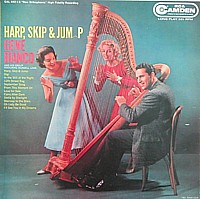Home · Listener's Guide · The Songs · Who's Who · Liner Notes · Selected Tracks · What's New · Search

Gene Bianco
- Born Eugene Capobianco 29 March 1927, Hartford, Connecticut
- Died 7 May 2007, Queens, New York City, New York
If you're one of those who believe the music industry is a machine that grinds all originality and innovation into a shrinkwrapped, packaged product with the consistency of Velveeta, Gene Bianco could be your poster boy. RCA turned this virtuoso harpist with a passion for jazz into a trademarked headliner for its easy listening record club partnership with Readers' Digest.
 He began studying the harp as a boy, following the example of his grandfather, Fillippo Capobianco, who had been a successful harpist in Italy. He was enough of a prodigy that he became a pupil of the famed classical harpist, Marcel Grandjany, in his teens. After attending Juilliard, he toured as a classical act, performing with a number of major orchestras. The New York Times wrote of his Carnegie Recital Hall performance of the premiere of Marcel Grandjany's "Rhapsody for Harp and Orchestra" that "Mr. Bianco's performance was brilliant. His conception of the impressionists was superb."
He began studying the harp as a boy, following the example of his grandfather, Fillippo Capobianco, who had been a successful harpist in Italy. He was enough of a prodigy that he became a pupil of the famed classical harpist, Marcel Grandjany, in his teens. After attending Juilliard, he toured as a classical act, performing with a number of major orchestras. The New York Times wrote of his Carnegie Recital Hall performance of the premiere of Marcel Grandjany's "Rhapsody for Harp and Orchestra" that "Mr. Bianco's performance was brilliant. His conception of the impressionists was superb."
He spent two years playing with the house orchestra at Radio City Music Hall. But he was fascinated with jazz and began experimenting on his own. Almost no one considered the harp a jazz instrument at the time, so Bianco's first attempts were inspired by George Shearing's blocked chord piano playing and Bobby Hackett's delicate cornet solos.
He began appearing as a solo act in a variety of New York nightclubs. While appearing at the Hotel Lexington, he was offered a job playing with the studio band on Ernie Kovacs' pioneering television comedy show on NBC. Ironically, although fellow harpist Robert Maxwell composed the signature piece for the show's Nairobi Trio skits, "Solfeggio," Kovacs preferred Bianco's more swinging interpretation. Bianco was the only band member not on the NBC musical staff, which featured such stellar talents as drummer Don Lamond, percussionist Bobby Rosengarden, guitarist Mundell Lowe, and Duke Ellington alumnus Wendell Marshall.
Bianco delighted in the opportunity to play with these ace musicians, and he convinced Lowe to join him in forming a jazz combo, along with percussionist Joe Venuto. They recorded an album featuring two Bianco originals, "Chicago Swinger" and "New York Nitelife," for the obscure label, Major Records. Soon after, RCA signed him to a three-album contract.
The group recorded two albums for RCA's budget label, Camden: Stringin' the Standards and Harp, Skip and Jump!. The latter is the more interesting, with several Bianco originals. (Another Bianco tune, "A Midnight Breeze," was a single for Sid Feller.) Neither album is likely to appear on anyone's list of the ten greatest jazz albums, but the combination of Bianco and Lowe, playing together in tightly harmonized solos, is quite nice, a wonderful example of light jazz. New York Times music critic John S. Wilson wrote:
Whether he is playing a brooding solo or swinging freely along with Mundell Lowe, Gene Bianco's harp sparkles with a fresh new sound--a legato flow rather than the staccato plink of harp strings customarily heard with other harpists in a style that is more piano-like and chord-conscious than one customarily hears on the harp. Bianco's harp is soundly grounded in formal study but loosened and leavened by jazz influences and most important the unique combination of harp and guitar around which most of Bianco's arrangements are built....Billboard and Cashbox were equally enthusiastic: "a fresh and sparkling new sound"; "first-rate harp artistry." Harp, Skip, and Jump! sold an amazing 58,000 copies.
Unfortunately, RCA had a different idea of where the harp belonged. They bought out his combo contract and cut a new one, for a new record club partnership with Readers Digest. The new venture was aimed at the middle class market, where the stereo console had joined the rest of the living room furniture and needed a steady supply of musical wallpaper.
RCA recast Bianco as "The Rainbow Sounds of Bianco," and put his own personal logo on the front of his albums. They paid for first-class productions, with a full orchestra and prime studio time, and it can't be denied that the quality shows through. In fact, the first album, Joy to the World, is considered as one of the finest easy listening Christmas records, and stands a better chance of being reissued than either of his jazz albums.
The deal made both RCA and Bianco a lot more money than the jazz albums, but jazz remained Bianco's first love. At the end of the six-album contract, he opted for the anonymity and independence of life as a freelance session musician, and ended up playing on dozens of great jazz recordings. Although jazz prudes lift their noses at orchestral accompaniment, many jazz musicians dream of cutting an album with a full-blown orchestra. As the sole harpist in town with proven jazz chops, Bianco had a steady stream of sessions. He played on all three of Paul Desmond's gorgeous string albums, on Gil Evans' Blues in Orbit, on Herbie Mann's Push, Push, Alan Lorber's Lotus Palace, and many others. He also recorded with some of the best jazz singers around, including Carmen McCrae and Marlena Shaw. Some of his best session work of the 1960s and 1970s now shows up on sampling favorites such as the Blue Break Beats.
After 30 years as a studio player, Bianco retired his harp and went into the recording booth as a musical coordinator and contractor, screening and hiring musicians for recording sessions. Respected throughout the business, he worked with acts as diverse as Mary J. Blige, D Train, Stevie Nicks, and Natalie Cole. He even passed muster with Ray Charles, who's legendary having some of the toughest musical standards around. Although his pace relaxed a bit in his last years, he continued to work demand, and around 2001 put together the orchestra that accompanied tenor saxman Joe Lovano on Viva Caruso. And the combination of harp and electric guitar that he and Mundell Lowe pioneered is now a standard feature of many pop orchestrations.
Recordings
- Sentimental Bouquet, Major 1005
- Gene Bianco Quintet, Major 3011
- Stringin' the Standards, RCA Camden CAL-366
- Harp, Skip & Jump, RCA Camden CAS-452
- Joy to the World, RCA Victor CPM-104/CSP-104
- Music for a Summer Evening, RCCA Victor CPM-105/CSP-105
- Sweet Songs of Love, RCA Victor CPM-107/CSP-107
- Your All-Time Favorite Songs (As Chosen By Members of the RCA Victor Record Club), RCA Victor CSP-110
- Music To Make Your Heart Sing!, RCA Victor CPM-115
- Wonderful Waltzes of Richard Rodgers, RCA Victor CPM-125/CSP-125
Gene Bianco-->
S p a c e A g e P o p M u s i c
Home · Listener's Guide · The Songs · Who's Who · Liner Notes · Selected Tracks · What's New · Search
Email: editor@spaceagepop.com